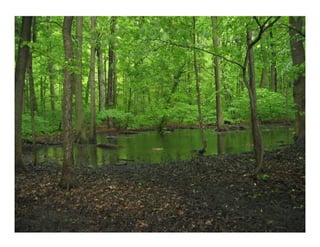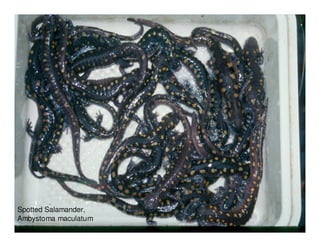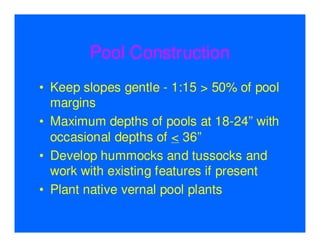Vernal Pools & Amphibians
- 1. Vernal Pools – World of Amphibians Mick Micacchion Ohio EPA, Wetland Ecology Group
- 2. Vernal Pools • Forested and Shrub depressions in a forested landscape • Isolated hydrology – primarily surface and ground water • Seasonal hydrology – ephemeral – at least late winter (Feb/March) to early summer (June/July) • Provide important amphibian breeding habitat
- 3. Amphibian Habitat Needs • Woodlands – especially important within 200m radius • Seasonal hydrology - March-June at minimum • Fish-free – bass, sunfish, pike, bullheads • Leaf litter/ Woody debris • Other breeding pools nearby
- 4. Ohio Vernal Pool Habitat Summary • Forest or shrub habitat • Forest surrounding pools • Other nearby pools • Seasonal hydrology • Surface water and/or groundwater hydrology • Fish-free • Leaf litter and woody debris • A habitat we are losing in Ohio • Complex ecosystems, not easy to replicate
- 5. Vernal Pool Habitat in Ohio • A habitat that is disappearing at alarming rates • Many species that rely on this habitat are becoming rare • Those habitats that are remaining need to be protected • Development of additional habitat is critically needed to help reverse the trend
- 6. Ohio Monitored over 200 wetlands for amphibians
- 10. Amphibian Habitat Needs Salamanders 12.6 hectares 31.0 acres 1000 meters 200 meters Wood Frogs 314.0 hectares 775.9 acres
- 14. Western Chorus Frog, Pseudacris triseriata
- 17. Northern Leopard Frog Lithobates pipiens
- 18. Northern Leopard Frog, Lithobates pipiens
- 21. Wood Frog Distribution From Davis and Menze 2000
- 22. Wood Frog Reproduction Ecology • Late winter/early spring, males advertise • Only breed for a few days each year • Communal egg laying • 800- 1200 eggs per mass • Larvae metamorphose in about 90 days • Males mature in 1 year, females in 2 years • Adults live 3 to 4 years tops
- 24. Wood Frog Egg Collection • Clear Creek Metro Park and other sites in Hocking Co. • Collected and moved 750,000 eggs • Collected by hand • Eggs iced in buckets with water and trucked • Eggs deposited same day
- 25. Repatriation Sites • 3 Metro Parks • Sites that once had wood frogs • 30,000-50,000 eggs per pool • Cluster eggs together
- 26. Success Criteria • Successful breeding – Large numbers of breeding adults in the pools – A like number of eggs, tadpoles and metamorphs • Healthy populations of wood frogs throughout the parks • Long-term viability of the populations • No human intervention required
- 35. Spotted salamander A. maculatum response to % forest coverage 1 Probability of A. maculatum occupancy Classification Tablea Predicted Ambystoma maculatum Percentage Observed 0 1 Correct Step 1 Ambystoma 0 17 3 85.0 maculatum 1 4 12 75.0 Overall Percentage 80.6 a. The cut value is .500 0.5 0 0 25 50 75 100 % Forest within 200m Slide by Deni Porej
- 44. Four-toed Salamander, Hemidactylium scutatum Photo by Jim Harding
- 45. Four-toed Salamander and eggs Photo by Mike Graziano
- 46. Identifying Potential Sites • Hydric soil areas where hydrology can be restored by minimal construction – breaking tiles – plugging ditches • Existing woodlands – In field or old field surrounded by woodlands or nearby (within 200m) – Located in existing woodlands • Restoration preferred • Creation if all other factors are good
- 47. Identifying Potential Sites • Existing populations of breeding amphibians – Close enough to migrate to new wetlands – Repatriations should only be a last gasp attempt • Extremely labor intensive • Low probability of success • Locate near existing vernal pools – Metapopulation dynamics – Breeding success
- 48. Construction Techniques MINIMIZE THE DISTURBANCE! • Keep engineering simple -break tiles/plug ditches • Move as little soil as possible • Work with existing landscape features – Use existing depressions – Work around existing mature trees • Stockpile and replace top soil, leaf litter and woody debris
- 49. Pool Construction • Keep slopes gentle - 1:15 > 50% of pool margins • Maximum depths of pools at 18-24” with occasional depths of < 36” • Develop hummocks and tussocks and work with existing features if present • Plant native vernal pool plants
- 50. Predicted “High Quality” Vernal Pool Locations




















































